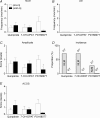Specific role of dopamine D1 receptors in spinal network activation and rhythmic movement induction in vertebrates
- PMID: 19204052
- PMCID: PMC2678221
- DOI: 10.1113/jphysiol.2008.166314
Specific role of dopamine D1 receptors in spinal network activation and rhythmic movement induction in vertebrates
Abstract
Dopamine (DA) is well-recognized for its determinant role in the modulation of various brain functions. DA was also found in in vitro isolated invertebrate preparations to activate per se the central pattern generator for locomotion. However, it is less clear whether such a role as an activator of central neural circuitries exists in vertebrate species. Here, we studied in vivo the effects induced by selective DA receptor agonists and antagonists on hindlimb movement generation in mice completely spinal cord-transected (Tx) at the low-thoracic level (Th9/10). Administration of D1/D5 receptor agonists (0.5-2.5 mg kg(-1), i.p.) was found to acutely elicit rhythmic locomotor-like movements (LMs) and non-locomotor movements (NLMs) in untrained and non-sensory stimulated animals. Comparable effects were found in mice lacking the D5 receptor (D5KO) whereas D1/D5 receptor antagonist-pretreated animals (wild-type or D5KO) failed to display D1/D5 agonist-induced LMs. In contrast, administration of broad spectrum or selective D2, D3 or D4 agonists consistently failed to elicit significant hindlimb movements. Overall, the results clearly show in mice the existence of a role for D1 receptors in spinal network activation and corresponding rhythmic movement generation.
Figures







Similar articles
-
Role of spinal 5-HT2 receptor subtypes in quipazine-induced hindlimb movements after a low-thoracic spinal cord transection.Eur J Neurosci. 2008 Dec;28(11):2231-42. doi: 10.1111/j.1460-9568.2008.06508.x. Epub 2008 Nov 3. Eur J Neurosci. 2008. PMID: 19019202
-
Contribution of spinal 5-HT1A and 5-HT7 receptors to locomotor-like movement induced by 8-OH-DPAT in spinal cord-transected mice.Eur J Neurosci. 2006 Jul;24(2):535-46. doi: 10.1111/j.1460-9568.2006.04917.x. Epub 2006 Jul 12. Eur J Neurosci. 2006. PMID: 16836640
-
Synergistic effects of D1/5 and 5-HT1A/7 receptor agonists on locomotor movement induction in complete spinal cord-transected mice.J Neurophysiol. 2008 Jul;100(1):160-8. doi: 10.1152/jn.90339.2008. Epub 2008 May 14. J Neurophysiol. 2008. PMID: 18480366
-
D3 and D1 receptors: The Yin and Yang in the treatment of restless legs syndrome with dopaminergics.Adv Pharmacol. 2019;84:79-100. doi: 10.1016/bs.apha.2019.01.002. Epub 2019 Feb 18. Adv Pharmacol. 2019. PMID: 31229178 Review.
-
Receptor subtype-specific dopaminergic agents and unconditioned behavior.Pol J Pharmacol Pharm. 1991 Nov-Dec;43(6):507-28. Pol J Pharmacol Pharm. 1991. PMID: 1687945 Review.
Cited by
-
Full anatomical recovery of the dopaminergic system after a complete spinal cord injury in lampreys.Neural Plast. 2015;2015:350750. doi: 10.1155/2015/350750. Epub 2015 Mar 24. Neural Plast. 2015. PMID: 25861481 Free PMC article.
-
Chewing prevents stress-induced hippocampal LTD formation and anxiety-related behaviors: a possible role of the dopaminergic system.Biomed Res Int. 2015;2015:294068. doi: 10.1155/2015/294068. Epub 2015 May 17. Biomed Res Int. 2015. PMID: 26075223 Free PMC article.
-
Opposing aging-related shift of excitatory dopamine D1 and inhibitory D3 receptor protein expression in striatum and spinal cord.J Neurophysiol. 2016 Jan 1;115(1):363-9. doi: 10.1152/jn.00390.2015. Epub 2015 Nov 11. J Neurophysiol. 2016. PMID: 26561599 Free PMC article.
-
New Developments on the Adenosine Mechanisms of the Central Effects of Caffeine and Their Implications for Neuropsychiatric Disorders.J Caffeine Adenosine Res. 2018 Dec 1;8(4):121-131. doi: 10.1089/caff.2018.0017. Epub 2018 Dec 7. J Caffeine Adenosine Res. 2018. PMID: 30596206 Free PMC article. Review.
-
Preclinical evidence supporting the clinical development of central pattern generator-modulating therapies for chronic spinal cord-injured patients.Front Hum Neurosci. 2014 May 30;8:272. doi: 10.3389/fnhum.2014.00272. eCollection 2014. Front Hum Neurosci. 2014. PMID: 24910602 Free PMC article. Review.
References
-
- Barbeau H, Rossignol S. Initiation and modulation of the locomotor pattern in the adult chronic spinal cat by noradrenergic, serotonergic and dopaminergic drugs. Brain Res. 1991;546:250–260. - PubMed
-
- Barriere G, Mellen N, Cazalets JR. Neuromodulation of the locomotor network by dopamine in the isolated spinal cord of newborn rat. Eur J Neurosci. 2004;19:1325–1335. - PubMed
-
- Bernaerts P, Tirelli E. Facilitatory effect of the dopamine D4 receptor agonist PD168,077 on memory consolidation of an inhibitory avoidance learned response in C57BL/6J mice. Behav Brain Res. 2003;142:41–52. - PubMed
-
- Bjorklund A, Skagerberg G. Evidence for a major spinal cord projection from the diencephalic A11 dopamine cell group in the rat using transmitter-specific fluorescent retrograde tracing. Brain Res. 1979;177:170–175. - PubMed
Publication types
MeSH terms
Substances
LinkOut - more resources
Full Text Sources
Medical
Molecular Biology Databases

